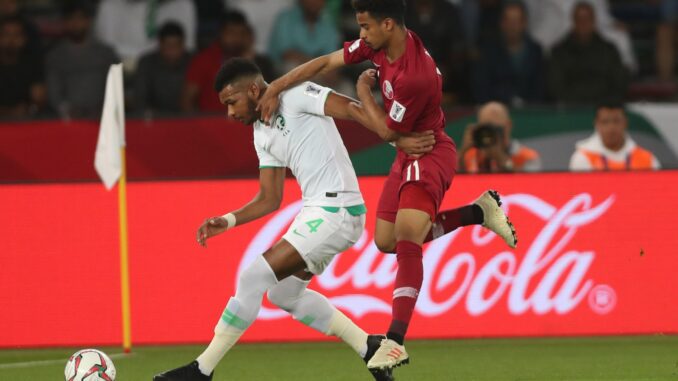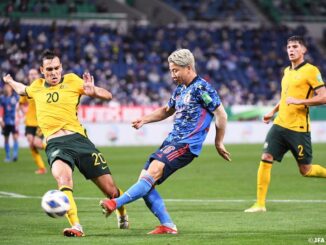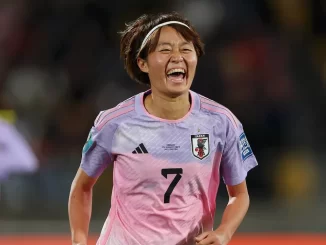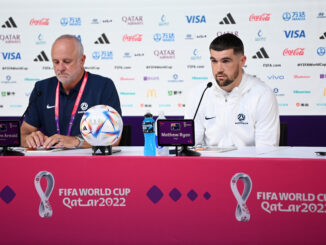

The Asian Game’s coverage of the FIFA World Cup Qatar 2022 is proudly sponsored by SMC.
Friday evening, as much of the continent tucked themselves into bed was hardly the most opportune moment to reveal a World Cup squad.
Yet rather than a formally arranged press conference to greet the awaiting media, both Saudi Arabia and hosts Qatar baulked at the gate, a tad earlier than some had expected, in revealing their 26-men squad selections.
Both sides had already alluded to their final squad makeups over the last few weeks; Saudi Arabia had decamped with an extended 33-man squad to Abu Dhabi two weeks ago, while Qatar had already confirmed a 27-man shortlist late last month, as they finalised their preparations in Spain.
While the names in contention left little ambiguity, form and fitness remained under the microscope up until the last minute ahead of this final announcement.
If we were left in little doubt to how Messrs Renard and Sanchez aim to set up in Qatar next week, these selections hone expectations that little bit more ahead of the big World Cup kick off in just under a week’s time.
Renard opts for stability in favour of flamboyance
The big question marks hanging over Saudi Arabia’s UAE training camp this last fortnight undoubtedly concerned fitness issues over any particular selection quandary Herve Renard may have had.
On the pitch, it was business as usual for Saudi Arabia, with a reassuringly solid defence and limp attack doing little to shake off the stable but ineffective tag the team had been developing over the last 12 months.
On the sidelines, however, one after another, Green Falcon fans have had their hearts in their mouths in anticipation of yet another injury scare to another big player.
Renard’s final squad selection, therefore, comes as a cooling tonic to concerns that key elements of their starting game plan were poised to miss out entirely.
National team captain Salman Al-Faraj’s heavily bruised shoulder, sustained in Saudi Arabia’s narrow victory over Iceland last week, was particularly alarming.
As the creative linchpin of the side, his experience and guile has almost single handily propelled this team of late. His telepathic understanding with fellow Al-Hilal star Salem Al-Dawsari (another in recovery following a spite of appendicitis) was integral if Al-Akhdar have any hope of clinging to possession, let alone fashioning some worthwhile goalscoring opportunities.
In that regard, the ever-frustrating pursuit of a reliable number nine is at risk of running by unheralded. Renard ran through four varying alternatives, all of whom were young and nervy, without as much of a glimmer that they’d be suitable to start as their front man against Messi and Co. come the 22nd of this month.
The dearth of options possibly forced Renard’s hand in selecting a recovering Saleh Al-Shehri. Irrespective of whether fit or not, he looks to be wheeled out in their opener against Argentina. The Al-Hilal central striker hasn’t had the best track record with injuries over the last year, even prior to his recent set back, but his form when called upon for his country remains a bright light amidst a sea of trepidation in front of goal.
The reliance on more predictable options in the end sealed the fate of the more exciting fringe picks from the extended squad. Abdullah Al-Hamdan clearly didn’t ever truly command the confidence of Renard over the last twelve months, while Nawaf Al-Abed only made it through the back door following Fahad Al-Muwallad’s withdrawal on Sunday. Certain key decisions seem to play to stability over flair.
The exclusion of Ayman Yahya may have not been too much of a surprise then. The U23 Asian Cup MVP from earlier in the year, who offered something different to the squad given his movement and interplay between midfield and attack, was in the end probably too difficult to facilitate within an already fixed tactical setup.
His replacement Haitham Asiri, another continental champion at U23 level but one that now plays in the second tier of Saudi Arabia (one of two squad members at recently relegated Al-Ahli), in the end benefitted from being in the right place at the right time earlier this week in prodding home the equaliser against Panama.
Not the headline grabbing performance needed necessarily, but a goal’s a goal – or as the coach may hope for, a goalscorer’s a goalscorer; for a side that has only scored seven goals in 13 matches this year. Any whiff of clinical potential is something Renard will enthusiastically cling to this close to the eve of the tournament.
Tried and trusted for Qatar, but where’s the excitement?
In a lot of ways Felix Sanchez’s Qatar squad has been a long time coming. Given the options at his disposal, and the coach’s now infamous stubbornness towards newcomers, the bulk of this squad had arguably been selected three years ago when the Spanish coach guided Qatar to a surprise Asian Cup title back in early 2019.
While that triumph represented a significant milestone in Qatar’s rapid rise in footballing stature, to a man, making this squad physically intact and in positive form was of the upmost of importance.
For months now, Qatar has been shielded by a QFA installed media-proof bubble, only emerging when needed for official FIFA windows. Qatar’s recent preparation for their on-field exploits couldn’t have been talked about less when compared to the wider organisational scrutiny the tournament as a whole is subjected to on an hour-by-hour basis.
Over the last six months, Sanchez had already trimmed his squad down to 27 for their final leg of their preparatory tour in Marbella. Apart from one unlucky custodian, Mustafa Meshaal, this squad has been broadly settled for some time, having made it thus far unscathed. In a period of time where fellow qualifiers have been sweating on the fitness of key players, Qatar has been left relatively unscathed.
If nothing else, the planning in putting together this squad, from way back in 2010 is highly commendable. Fifteen of the squad were part of the Asian Cup winning side from three years ago. Eighteen of the squad were formed at the Aspire Academy talent factory that was created for this very purpose. A further five were nationalised in 2010 on the back of their successful World Cup bid. This has been a plan executed to precision.
While the squad assembly has been followed to the letter, the concern instead focuses on what kind of form this very tight squad can offer. Of those who starred in UAE back in 2019, you’d find it difficult to make a case for any of them being in better form in 2022. Equally Sanchez’s tactical approach seems to be retreating in response to either a potential dip in confidence or simply a slowly stagnated mood around camp.
For most of the players this will be their fifth major tournament in three years; 2019’s Asian Cup, 2019’s Copa America, 2021’s Gold Cup, and 2021’s Arab Cup ahead of 2022’s World Cup. This squad’s unity, once the catalyst for success, is now something that is starting to wane in allure, with most fans instead left calling for some youthful excitement from outside.
There are elements of this squad that could change that feel; adventurous left wing back Homam Ahmed is one of the few starters that actually complements the now cautiously minded 5-3-2 set-up, while Mohammed Waad is a flexible option in covering midfield and defence.
The most intriguing fringe pick, however, sees the return to the fold of midfielder Ali Assadalla. Overlooked for Qatar’s Asian Cup success, he’s taken a while to return to the sort of form he demonstrated in Qatar’s Gulf Cup success back in 2014.
His place within the squad, cruelly yet oddly symmetrical, sees Abdullah Al-Ahrak, in many ways Assadalla’s successor, similarly miss out on the final cut this time through injury. Looking over to his contemporary Assadalla, there is at least a sense of redemption available for the future.
For the 26-men called up, however, the future is a significantly distant thought. As Qatar head home to the rising expectation back in Doha, a squad in the main formed over a decade ago has the weight of a nation bearing down on their shoulders.
Photo: QFA
Listen to the latest episode of The Asian Game Podcast as we preview Japan ahead of the FIFA World Cup




